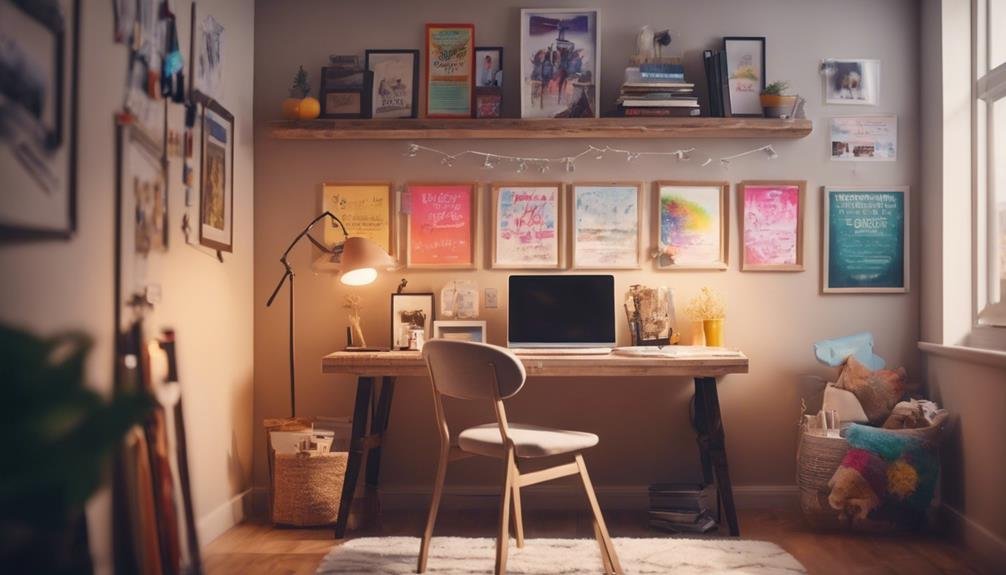Creating a Positive Learning Environment at Home
In the hustle and bustle of daily life, between work emails and household chores, it can sometimes be a challenge to switch gears and create a positive learning environment at home.
However, by implementing a few key strategies, you can transform your living space into a hub of growth and development for your family. From setting up a dedicated learning space to prioritizing well-being and mindfulness, each step plays a vital role in fostering a successful learning environment.
But what makes these elements truly effective?
Key Takeaways
- Designate a dedicated learning space for focused studying.
- Establish consistent daily routines to enhance efficiency.
- Encourage open communication for a supportive environment.
- Incorporate fun and interactive activities to promote engagement and learning.
Setting up a Dedicated Learning Space

To optimize focus and productivity, designate a specific area in your home solely for learning activities. By organizing supplies neatly in this space, you create a conducive environment for studying. Having easy access to pens, papers, textbooks, and other necessary materials helps streamline your learning process. A clutter-free and well-organized area can enhance your concentration and overall learning experience.
Additionally, personalizing the decor of your dedicated learning space can make it feel more inviting and inspiring. Consider adding elements that motivate you, such as inspirational quotes, plants, or artwork. These personal touches can help create a positive and engaging atmosphere that encourages you to spend time in this space.
Establishing Consistent Daily Routines
Establishing consistent daily routines plays an important role in fostering a structured learning environment that promotes efficiency and academic success. Time management is crucial in ensuring that your day is well-utilized for learning. A structured schedule helps in creating a sense of normalcy and predictability, reducing stress, and enhancing focus on educational tasks. Here is an example of how your daily routine could be structured:
| Time | Activity |
|---|---|
| 8:00 AM | Morning Routine |
| 9:00 AM | Math Lesson |
| 10:00 AM | Break |
| 10:15 AM | Reading Session |
| 11:15 AM | Science Activity |
| 12:00 PM | Lunch Break |
| 1:00 PM | Writing Assignment |
| 2:00 PM | Physical Exercise |
| 3:00 PM | Review and Recap |
Encouraging Open Communication

Moving onwards from establishing consistent daily routines, fostering open communication within the household is fundamental for creating a positive learning environment at home. Essential listening plays a vital role in this process. When you actively listen to your family members, you show them that their thoughts and feelings are valued. This practice not only enhances understanding but also strengthens bonds within the family.
By encouraging open dialogue, you create a safe space where everyone feels comfortable expressing themselves.
Fostering trust is another key aspect of promoting open communication. When trust exists within the family unit, individuals are more likely to share their thoughts and concerns without fear of judgment. This trust forms the foundation for healthy communication patterns. By being open, honest, and supportive, you set the stage for meaningful interactions that can lead to insightful discussions and problem-solving.
Incorporating Fun and Interactive Activities
Incorporating engaging and interactive activities into your daily routine can greatly enhance the learning experience for everyone in the household. Outdoor exploration offers a fantastic opportunity for hands-on learning. Encourage your family to go on nature walks, identify plants and animals, or simply enjoy the fresh air. Through this, not only do you promote physical activity but also stimulate curiosity and observation skills.
Creative expression is another powerful tool to foster a positive learning environment at home. Set aside time for arts and crafts, storytelling, or even dramatic play. These activities not only encourage imagination but also help in developing communication and problem-solving skills. Additionally, engaging in creative endeavors can be a great stress reliever for both children and adults.
Prioritizing Well-being and Mindfulness

Encouraging a focus on well-being and mindfulness can greatly contribute to creating a positive and nurturing learning environment at home. Prioritizing self-care practices and mindfulness techniques not only enhances mental health but also fosters emotional well-being in both you and your child. By incorporating these practices into your daily routine, you can create a harmonious atmosphere that promotes growth and learning.
| Self-Care Practices | Mindfulness Techniques | Benefits |
|---|---|---|
| Engage in physical activity | Practice deep breathing exercises | Reduces stress and anxiety |
| Prioritize healthy eating habits | Practice mindfulness meditation | Improves focus and attention |
| Get enough quality sleep | Practice gratitude journaling | Enhances mood and positivity |
| Take regular breaks | Engage in sensory activities | Boosts creativity and problem-solving skills |
Frequently Asked Questions
How Can Parents Effectively Balance Work Responsibilities With Supporting Their Child's Learning at Home?
Balancing work with supporting your child's learning at home requires effective time management and strong communication skills. Prioritize tasks, set boundaries, and communicate openly with your employer and family to achieve work-life balance while providing emotional support to your child.
What Are Some Strategies for Helping Children Stay Motivated and Engaged in Their Schoolwork at Home?
You can boost your child's motivation and engagement by creating a routine together. Start by setting specific study times, breaks, and rewards. This structure helps them feel supported and accountable, fostering a positive learning environment at home.
How Can Parents Address Conflicts or Disagreements That May Arise During Homeschooling Sessions?
Address conflicts by nurturing strong communication skills. Listen actively, validate emotions, and collaborate on solutions. Engage parents to provide emotional support and guide conflict resolution. Encourage open dialogue, empathy, and understanding for a harmonious homeschooling experience.
Are There Specific Resources or Tools That Can Help Parents Track Their Child's Progress and Academic Growth at Home?
To track your child's progress and boost academic growth, utilize educational tools like online platforms, progress tracking apps, and parent resources such as educational websites. These resources offer insights and support for effective monitoring and improvement.
How Can Parents Ensure That Their Child Is Developing Social Skills and Connections While Learning From Home?
To guarantee your child develops social skills and connections while learning from home, encourage social interactions like virtual playdates. Support building friendships through group projects, fostering a sense of community and camaraderie in their educational journey.
Conclusion
To sum up, establishing a positive learning environment at home is essential for your child's academic success and overall well-being. By setting up a dedicated learning space, establishing consistent routines, encouraging open communication, and incorporating fun activities, you're fostering a conducive atmosphere for growth and development.
Remember, prioritizing your child's well-being and mindfulness is key. So, keep up the good work and continue to nurture a positive learning environment, even if it means sacrificing your own sanity in the process.








